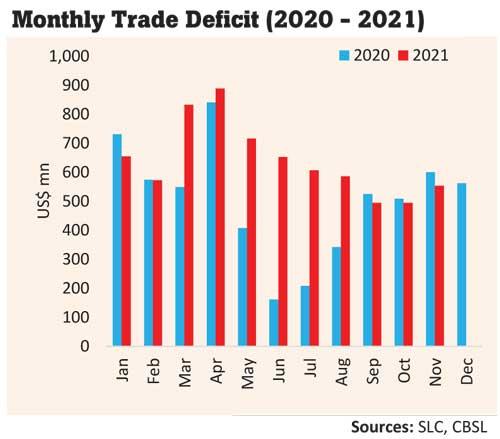26 Jan 2022 - {{hitsCtrl.values.hits}}
Sri Lanka’s November trade deficit fell amid stronger exports, which outpaced a soaring import bill due to higher global commodities prices, in particular the price of oil and the higher demand set forth with high amount of liquidity made available since the start of the pandemic.
 According to the merchandise trade data released for November 2021, Sri Lanka exported goods worth US$ 1, 211 million and imported goods worth US$ 1,765 million, up 54.6 percent and 27.5 percent respectively, resulting in a trade deficit of US$ 553 million. This in comparison was a decline from the US$ 600 million deficit recorded in the same month in 2020.
According to the merchandise trade data released for November 2021, Sri Lanka exported goods worth US$ 1, 211 million and imported goods worth US$ 1,765 million, up 54.6 percent and 27.5 percent respectively, resulting in a trade deficit of US$ 553 million. This in comparison was a decline from the US$ 600 million deficit recorded in the same month in 2020.
However, the 11-month deficit in the trade account reported a record US$ 7,051 million, rising from US$ 5,446 million in the same period in 2020 on the back of US$ 11,345 million exports
and US$ 18, 396 million imports, which grew by 24.9 percent and 26.6 percent respectively from the same period in 2020.
While the exports received a tailwind since June this year from the stronger demand conditions prevailed throughout the pandemic and also from the higher global commodities prices, the imports climbed much higher due to the elevated energy costs and other commodities prices, and also due to the strong demand conditions that prevailed at home with lot more liquidity being available.
This was evident from the 8.1 percent deterioration seen in the terms of trade in November 2021 from the same month in 2020 as the increase in prices of imports surpassed the increase in prices of exports.
Fuel bill emerged again as the biggest culprit for the trade deficit in the eleven months, due to its rapid recovery in oil prices since the global economy began opening up after months long lockdowns as the industrial demand came roaring back as seen in the global purchasing managers’ index data.
Fuel bill for November shot up 78 percent to US$ 318.6 million as all of the oil bought were in refined form as no crude oil imports happened due to the dollar crunch to operate the refinery. In the 11 months, the cumulative oil bill rose by 43 percent to US$ 3,300.4 million over the same period in 2020.
Merchandise exports however delivered a record breaking US$ 1,211.5 million in November, continuing the billion dollar streak for the sixth month as the country ramped up its production to meet the robust demand that came from the United States, Europe and elsewhere. Textiles and garments exports provide a close proxy for this phenomenon in the West and across Europe as the earnings from this category climbed nearly 53 percent in November to nearly US$ 500 million while the 11-month exports also rose by a robust 23.4 percent to US$ 4,901.9 million.
As a result, the total industrial exports rose by 56.6 percent in November to US$ 935.4 million with the cumulative eleven months exports rising by 27.1 percent to US$ 8,788.4 million from the same period in 2020.
Meanwhile, agricultural exports rose by 46.9 percent to US$ 268.9 million with 11-month exports rising by 17.1 percent to US$ 2,497.2 million from the same period in 2020.
Despite the concerns surrounding the fallout from the shortage of fertiliser, the three key commercial crops tea, rubber and coconut did better through November.
The spice exports also rose by over 36 percent in both November and in the eleven months to November to US$ 411.1 million, bringing the highest amount of earnings from Ceylon spices.
Meanwhile, in the imports basket, consumer goods imports rose by nearly 20 percent in November to US$ 305.8 million with all sub-categories recording increases, except for dairy products, vegetables and seafood.
The 11-month consumer goods imports expenditure was US$ 3,429.4 million, up 11.6 percent.
Meanwhile, the intermediate goods imports, bulk of which comprises of fuel and textiles and related articles, rose by 24.3 percent to US$ 1,017.2 million in November with the cumulative imports rising by 33.2 percent to US$ 10,940.7 million.
The investment goods imports, which comprise of machinery and equipment, building materials and transport equipment, rose by a robust 40.2 percent to US$ 433.7 million with the cumulative imports rising by 24.1 percent to US$ 4,009.8 million.
16 Nov 2024 10 minute ago
16 Nov 2024 25 minute ago
16 Nov 2024 31 minute ago
16 Nov 2024 37 minute ago
16 Nov 2024 43 minute ago